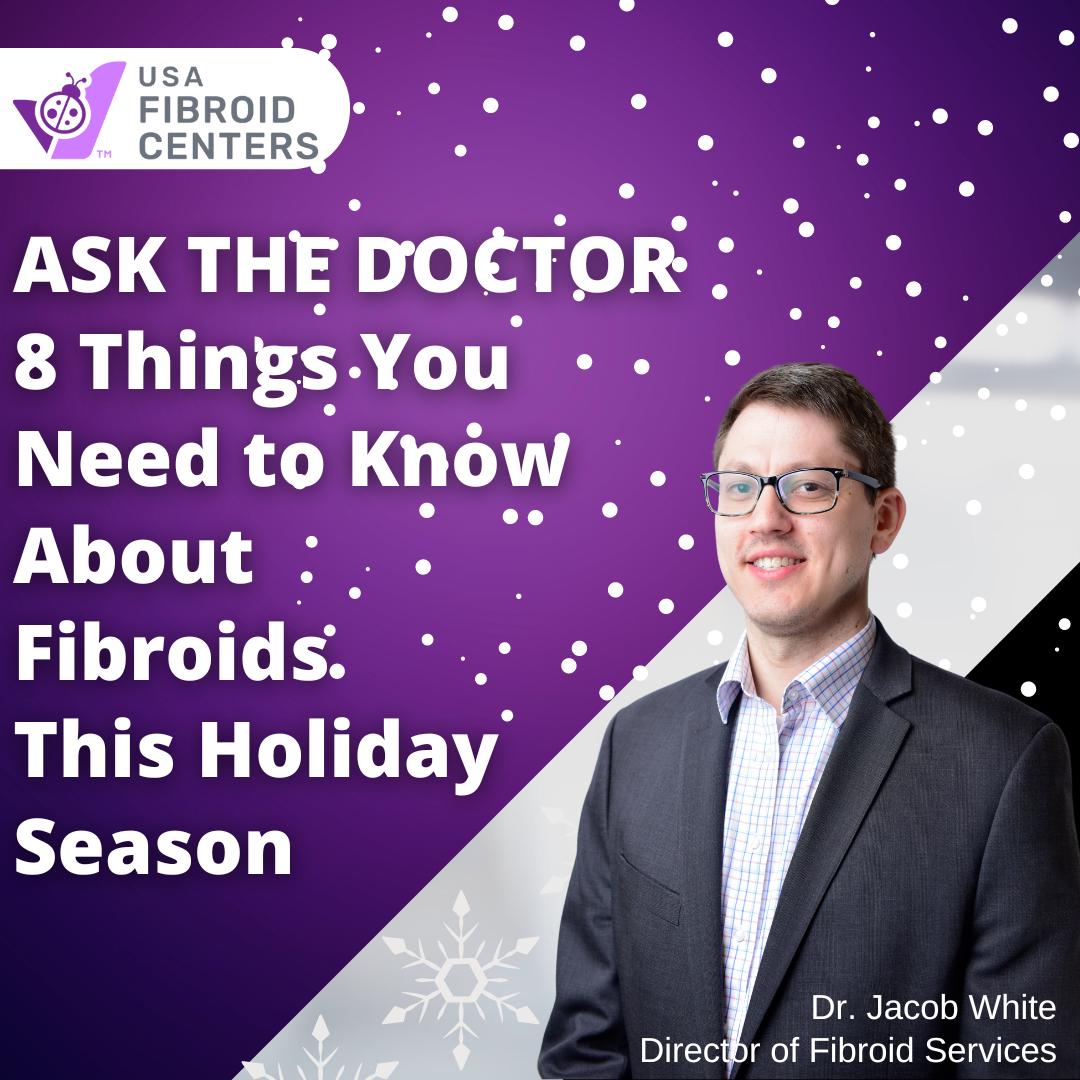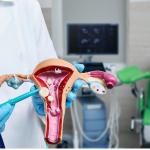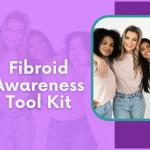
As the holiday season approaches, I find that most women I know dread it. Instead of the most wonderful time of the year, for many, it’s the most stressful. And women with uterine fibroids (an estimated 40% have them) suffer from a vast array of symptoms that make life very difficult.
While uterine fibroids are benign (noncancerous), they grow over time and can cause different issues. Depending on size, location, blood flow, hormone status, the orientation of the uterus, and many other factors, each fibroid can cause a unique set of symptoms.
LEARN MORE – MEET WITH A FIBROID SPECIALIST
Making the proper diagnosis is difficult, but our team of interventional radiologists at USA Fibroid Centers sees and treats them all. Here are 8 things you need to know if you suffer from fibroids during the holidays:
1. A Fibroid’s Lifecycle
The exact cause of uterine fibroids is not known. However, they tend to follow a particular growth pattern. We know that fibroids grow when hormones like estrogen and progesterone are high. They are highest when women are in their 20s and 30s or during pregnancy. It usually takes a few years of growth before a fibroid is big enough to cause symptoms. Fibroids stop growing and eventually shrink in size after menopause because hormone levels drop
Age plays a strong role in making the diagnosis and guiding the treatment of fibroids. A teenager is unlikely to have grown a fibroid large enough to cause symptoms, and a 70-year-old is unlikely to develop a fibroid at all. A fibroid that presents symptoms in a 30-year-old is likely to grow and cause more problems in the coming years, while a small fibroid in a 50-year-old is unlikely to grow or cause any issues.
2. Two Most Common Symptoms
The two most common symptoms of uterine fibroids are excessive menstrual bleeding and pelvic pain. When a fibroid grows in the center part of the uterus, the endometrium, it disrupts the natural menstrual cycle and causes heavier, prolonged, or more frequent bleeding. If left untreated, this type of fibroid will continue to grow, and the bleeding will get worse. The logistical nightmare created by so much blood loss involves tampons, pads, adult diapers (unfortunate but true), the need to be close to a restroom, and requiring days off from work every month to manage the bleeding.
I’m always amazed at all the hoops I hear of my patients jumping through to cope with excessive bleeding. As if that wasn’t enough, anemia can develop from blood loss. Anemia is low red blood cells. It can cause symptoms, such as fatigue, shortness of breath, dizziness, and more.
A fibroid that grows in the outer part of the uterus, far away from the endometrium, typically does not cause that many bleeding issues. Instead, pelvic pain is the dominant symptom. This pain can get worse during menstruation and intercourse. Medicines like ibuprofen or naproxen can initially treat the pain, but as the fibroid grows the pain intensifies.
3. When Fibroids Push Against Neighboring Organs
Uterine endometrium fibroids with bleeding and fibroids that grow outside of the uterus with pelvic pain are more straightforward to diagnose. But sometimes fibroids can cause other symptoms. These symptoms occur when fibroids grow close to another organ, get too large, or are so numerous the uterus becomes distorted and starts to push on the surrounding structures. When this happens, the patients often develop symptoms that may appear to be unrelated to the uterus and are frequently misdiagnosed.
FIND A FIBROID CENTER NEAR YOU
4. Urinary Frequency
The bladder is positioned directly in front of the uterus. When a fibroid grows from the front of the uterus, it can compress the bladder, rendering it unable to fill with urine. Since the bladder can’t expand, it can only hold a limited amount of fluid before signaling the need to empty. However, the patient only urinates a small amount of urine the bladder is holding.
I had a patient who would restrict her fluid intake to avoid frequent trips to the restroom. She also woke up every night (despite dehydrating herself) needing to urinate. Aside from being anxious when she left home, she was chronically tired from sleep interruptions. By the time the patient reached my office, she had been dealing with these symptoms for many years. She had undergone fruitless invasive diagnostic urological testing.
The patient had a uterine fibroid embolization procedure to shrink her fibroids. After two months, she reported that she no longer wakes up at night to urinate and has more energy now that she sleeps through the night. She even enjoyed a trip overseas touring Europe without constantly stopping for restroom breaks.
5. Constipation and Bloating
The colon, or large intestine, is positioned behind the uterus. A uterine fibroid that grows from the back of the uterus can compress the colon. The colon has an important job gathering the waste from the food we eat.
When a fibroid encroaches on the colon, it makes it harder for the colon to push the stool past it during a bowel movement, resulting in constipation and bloating. The colon is like a 6-lane highway with cars cruising along. A large fibroid can squeeze the colon down to only one or two lanes, creating a very uncomfortable traffic jam behind the narrowing. Since constipation is a frequent symptom of many medical issues and medications, it often goes unmentioned, undetected, or ignored.
Constipation symptoms may result in an appointment with a gastroenterologist and a colonoscopy. Even if the colon hasn’t impaired functionality, laxatives and stool softeners are often used to help move the stool past the fibroid.
When the patient finally gets referred to my office, I can diagnose fibroids and treat the underlying cause. The colon can now do its job effectively and without medication assistance.
7. Leg Pain
How does the uterus cause leg pain? Our brain and spinal cord are responsible for pain and sensation signals. We have nerve fibers that travel from the spinal cord in our back, down each leg, and back to the spinal cord. This allows our brains to process pain and sensory information.
In some cases, the fibroids grow towards these nerves compressing them. The compression causes nerve symptoms like shooting leg pain, numbness, and tingling. UFE treatment that shrinks the fibroids releases the pressure on the nerves and cures the leg symptoms.
8. Vascular Disease
Like the nerves that travel to and from the legs, we also have blood vessels that bring blood from the heart down to the legs and feet (called the arteries) and vessels bringing the used blood from the legs back up to the heart (called the veins). A fibroid compressing the blood vessels can cause many leg symptoms, from pain to bulging veins to a blood clot.
MORE QUESTIONS? TALK TO A FIBROID SPECIALIST NOW
Fibroid Diagnosis and Treatment
Fibroids are not always straightforward to diagnose. Because fibroids are so widespread, it is crucial for medical professionals and informed patients to keep an eye out for them as a possible cause of several ailments. The symptoms described in this article are only a few of the many ailments that fibroids can cause.
There are a few treatment options available for uterine fibroids. One of which is uterine fibroid embolization (UFE). UFE is a minimally invasive, same-day procedure performed in our offices. No hospital stay is required, and recovery typically lasts only about a week. UFE is very effective at shrinking fibroids and relieving the symptoms associated with them
Schedule a Consultation
If you suffer from the effects of fibroids, we encourage you to get help as soon as possible. Do not live with fibroid pain and discomfort any longer. Booking an initial consultation at USA Fibroid Centers is easy and convenient when you use our online scheduling system or call us at 855.615.2555.
About Dr. Jacob White
Dr. Jacob White is the Director of Fibroid Services at USA Fibroid Centers. He has been studying and practicing interventional radiology for over 15 years and is board-certified. He has conducted research at Drexel Hahnemann University Hospital Radiology, Georgetown University Hospital Radiology, and the National Institutes of Health Radiology. Dr. White has contributed extensive research and knowledge to the medical academy through a multitude of presentations and publications. All of our doctors specialize in minimally invasive, non-surgical procedures to treat uterine fibroids.
Read more “Ask the Doctor” blogs HERE.



